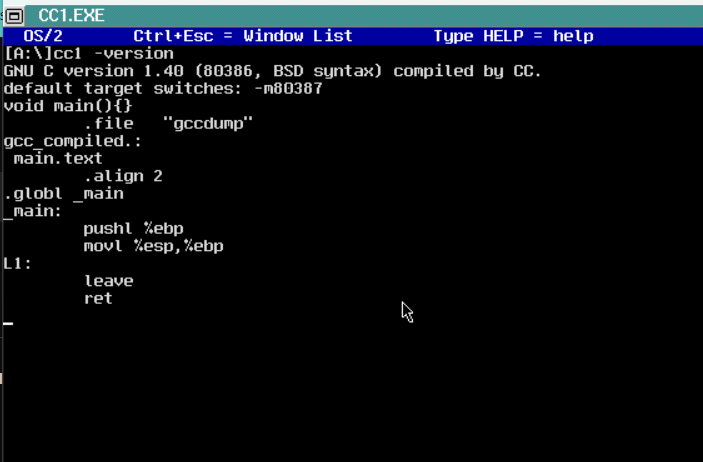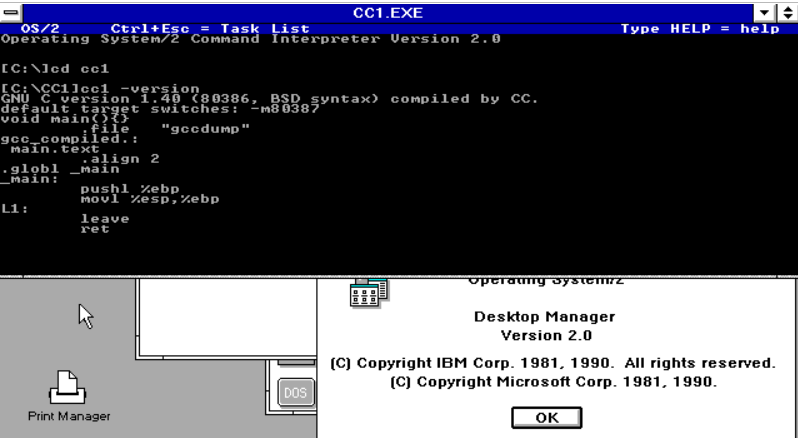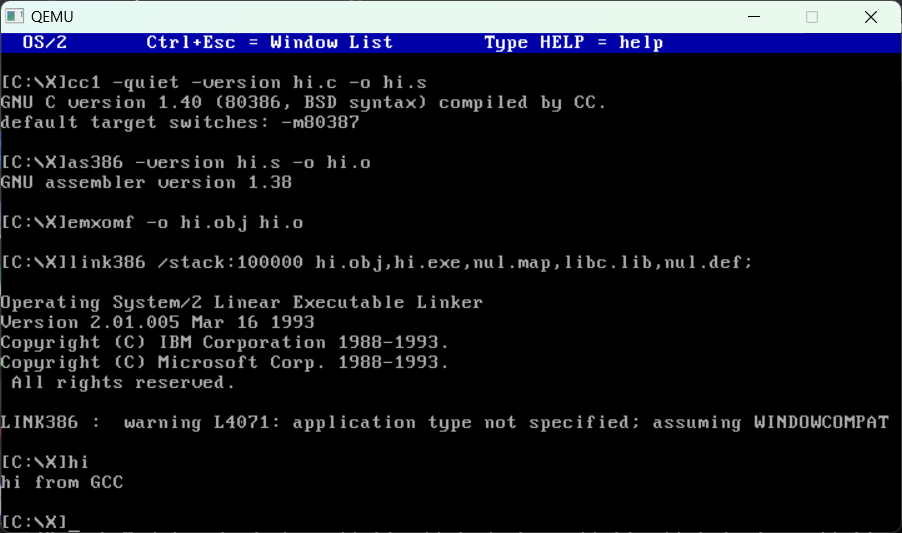I know what you are going to think, that it was already done, and it was called EMX. Or was it GCC/2? Well sure but what if you are not running the GA (General availability) version of OS/2. For example, years ago I had managed to get Citrix Multiuser 2.0, and it’s not at the GA level. All that is available is some ancient beta version of Microsoft C 5.2 from 1989?!
A little while back I had worked on getting GCC to build and run on the FPU enabled versions of Windows NT from 1991. I had mentioned that it turns out thanks to the Xenix assembler, that GCC had been basically available the entire time Windows NT had been available, but lamented that since the OS/2 compiler is 16/32bit, the 5.2 compiler couldn’t handle compiling GCC without blowing it’s heap. 16bit issues in a 64bit world.
However after doing some research on all the early cl386 compilers I could get my hands on, including the Windows NT Pre-release ones, I’d noticed that if I built CC1.EXE (the actual compiler) first for Win32, then rebuilt those object files with the December NT Pre-release compiler, that some versions of LINK386 from the OS/2 2.1 DDK would actually link with them. And sure enough it worked!

I have to admit I was pretty amazed, I had managed to ‘cross compile’ GCC using quite the tool chain.
First the compiler from the December NT Pre-release CD-ROM is shipped as a 16bit OS/2 compiler, but I’m using Windows 11. First I use the MS-DOS player with a quick fix from crazyc to allow Phar Lap 286|Dos Extender to run, which provides a basic enough OS/2 emulation to allow the compiler to run under ‘dos’. The linker on the DDK suffers the same fate as far as it also being 16bit. However the combination of MS-DOS player & Phar Lap gets stuff working! The only weird catch is that the 386 emulator causes strange floating point related crashes, while the 286 or 486 emulators work fine.
Now targeting OS/2 or running on OS/2 isn’t all that new, but building it from a Microsoft C compiler is. And now of course you’ll ask yourself, who cares? why is it interesting?
Well, the vast majority of the GCC ports to OS/2 don’t support the OMF object file binary standard, instead they used the much outdated a.out format, and rely on tools to convert the objects if needed. Additionally, they have DLL dependencies, and other startup issues with things needing to be setup. And of course they rely on a binary standard that is ‘GA’. *HOWEVER* by using a Microsoft compiler, I have OMF object files that the OS/2 built in system linker LINK386 can understand. So in plain English I can just relink the compiler and it’ll run on a new ‘version’ of unsupported OS/2.
I made a diskette image with my objects & a linker script and in a few moments I had it running!

The substantial thing here is that the binary format for OS/2 changed twice, and each release introduced changes that broke binary compatibility, in an effort to force people onto the new tools. So there is no way that the old ‘LE’ format would ever work. And you can see it’s running! In addition I could take the same object files, and copy them to my Citrix server, and likewise it was just a matter of linking, and it too now has GCC!

One annoying thing is that the LINK386 that ships with OS/2 2.00 GA doesn’t like the output of the Xenix assembler, so I built the a.out traditional assembler, and the emxomf tool to convert the a.out to OMF, and that worked well.
I still have much to mess with, including the pre-processor & main ‘gcc’ program. I have not built anything beyond a trivial program, so there is indeed much more work to be done before I can even try anything challenging. Some programs like emxomf have portions in the debug support that require the ‘long long’ type, which obviously Microsoft compilers from 1989-1991 don’t have, so I’ll have to re-build them with GCC.
Ive been putting my ports onto github (cl386-research) as it handles the rapid changes well enough. It’s a bit of a complex setup and it involves using a build system that I’ve put over on archive.org here: cl386-research-v2.
Not that I can imagine anyone wanting to try but I’ve uploaded some disks with the objects. Copy them to a hard drive, and run the ‘build.cmd’ command and it’ll link to a native freestanding executable.
I’ll explain it more with a post later, along with going over all the versions of cl386 I’ve acquired, over the years in more of a part 2: Targeting OS/2 with Visual Studio 2003!

Amazing stuff. I never developed C on x86 back then (but on 68000), but this read still amazes me. Keep on hackin’!
Thanks! I had never really thought about trying to get GCC built using the old period tools, as I just waited for other people to do it. Building GCC for the 1991 Windows NT Pre-Release was quite fun, but of course I wanted a version for OS/2. It’s been even more fun to try to fix generated assembly from VC 2003 into something MASM 6.11 can handle, and link those for OS/2.
It’s let me run a ns32016 emulator that relies on long long/int64 types that even old GCC 1.40 can do, while Microsoft C could not.
#!/bin/bash
export PATH=$PWD/bin:$PATH
export C_INCLUDE_PATH=$PWD/h
export GCCOS2=$PWD
sed ‘s@GCCOS2@'”$GCCOS2″‘@’ bin/wlink.template > bin/wlink.lnk
rtret
?